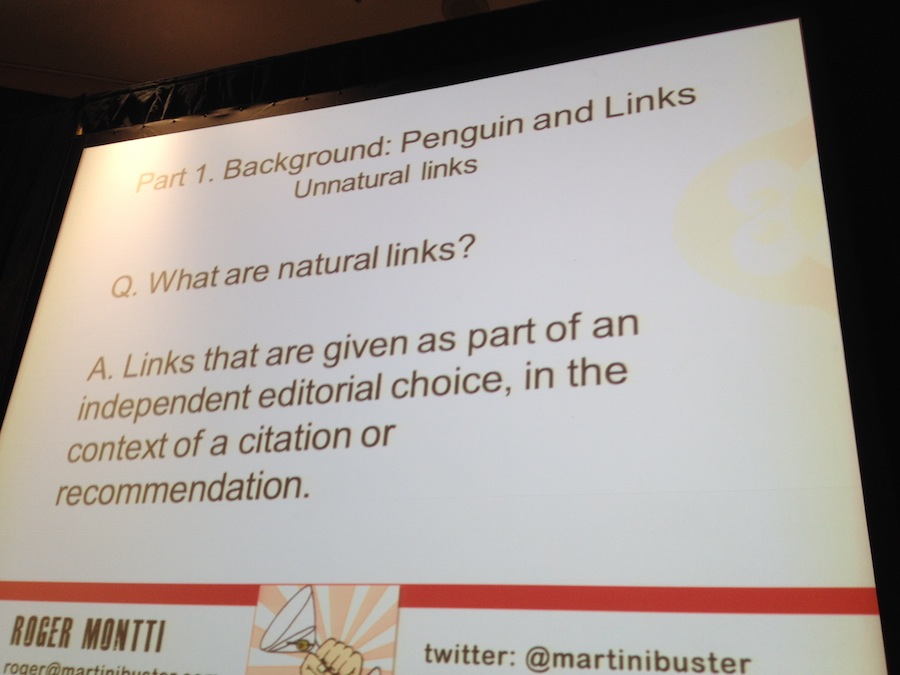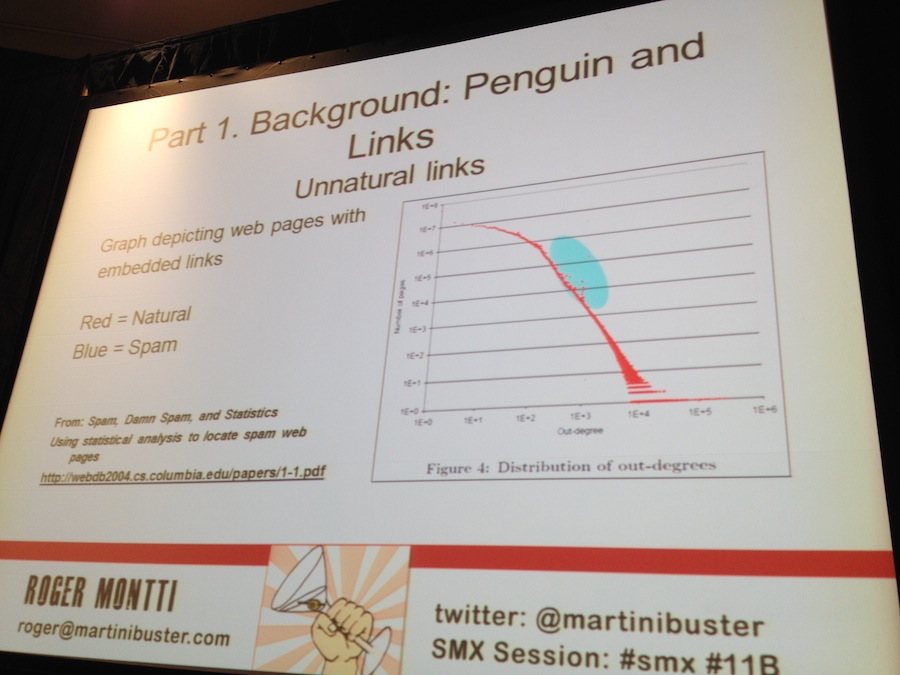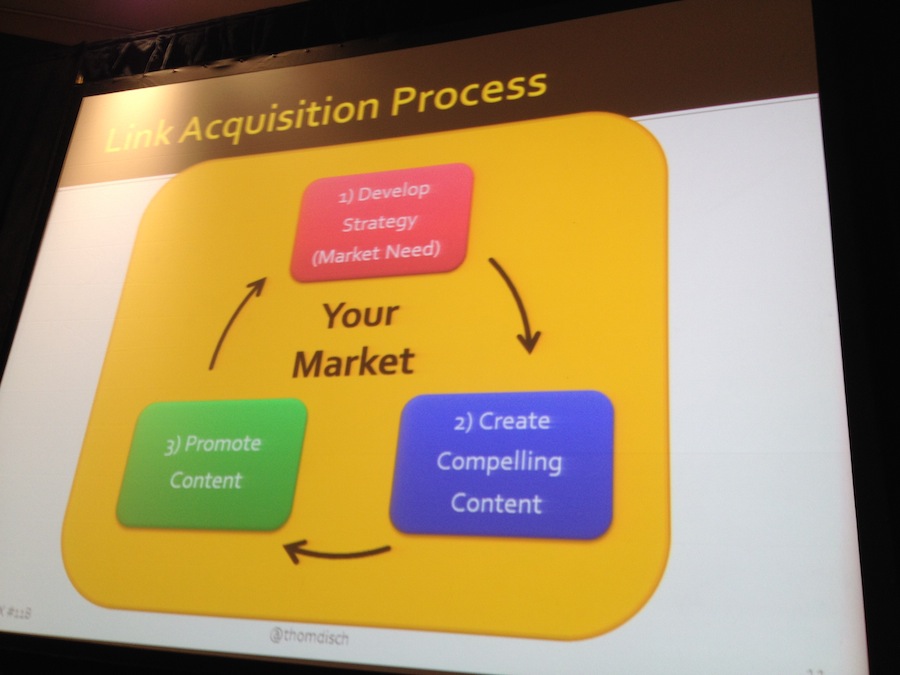Penguin-proof Link Building Tactics (#smx #11B)
I’m wide awake, it’s morning. Good album; great way to start the day. Breakfast is done and I’m ready to kick off SMX East right with a session on link building best practices and tactics to avoid.
Here’s the description from the Agenda – or skip right to the live blog goodness.
 Penguin-proof Link Building (#smx #11B)
Penguin-proof Link Building (#smx #11B)
Link building remains a lynchpin SEO tactic, but in a post-Penguin world you have to be cautious. This session discusses the link earning tactics you should apply in order to thrive, while everyone else is worried about disavowing links. You’ll also learn about common link building methods that may be harmful, and how to avoid the “Penguin trap” of having links work against you.
Moderator: Elisabeth Osmeloski, Director of Audience Development, Third Door Media, Inc. (@elisabethos)
Q&A Coordinator: Mark Traphagen, Director of Digital Outreach, Virante, Inc. (@marktraphagen)
Speakers:
Thom Disch, CEO, Handi-Ramp (@thomdisch)
Roger Montti, Owner, MartiniBuster (@martinibuster)
Neal Rodriguez, Managing Director, Shovecom (@notifyneal)
First up is Roger Montti, Owner, MartiniBuster (@martinibuster). He jokes that maybe the session should be called “Hummingbird-proof” link building. He says he has been doing link building for 10-plus years, and that he uses link-building strategy primarily for himself, but he also teaches clients.
His presentation will be broken down into three segments:
1) Background
2) Links to avoid
3) Penguin-proof link building strategy from travel niche website
He is going to show us a way forward; how to attract natural, penguin-proof links.
Part 1: Background
He asks if everyone knows the difference between natural and unnatural links. We all say yes (by show of hands) and he moves on. This section is mostly about defining natural links (IE: The links we want).
Any time you can dictate the anchor text, or the position of your link, that is going to be considered a unnatural link.
He specifically defines natural links as “links that are given as part of an independent editorial choice.”
Telling a story about PageRank in 2003; If you stick a link in the footer Google will crawl it but PageRank will be depreciated. This story is meant to clarify how important it is to have links on RELEVANT pages in order for PageRank to pass full link juice. IE: If you design a website for a dance company and link to your web design company, the link from a dance company to your web design company isn’t worth very much
Since 2003 Google has been on the campaign to depreciate links that aren’t actually valuable to UX. IE: links in footer that aren’t relevant aren’t worth as much.
SEOs have responded to this link devaluation by trying to get more and more and more links to make up for the individual link depreciation. The time for getting more and more and more links is pretty much over right now. Penguin/Hummingbird have made sure of that.
Roger says to ask yourself: “How can I create usefulness that will cause people to like it, share it, and link to it?”
He says reciprocal links aren’t necessarily penguin-proof.
If you want to be algo-proof you have look beyond what everyone else is doing and come back down to Earth; think: What is it Google is after?
He says his technique is always to just back off.
Natural and Unnatural are words that come out of statistical analysis. Google establishes a baseline for normal, and then considers sites outside of this baseline as spam.
Google’s web spam team includes advanced statistical analysis professionals. No matter how much you try to “look natural,” you can’t trick a statistical algorithm.
With all the mathematics that are involved in this you have to actually BE natural. You cant just look natural.
Shows us some stats. Blue are sites that are spamming – they pop out.
PART 2. Links to Avoid – unnatural links
Anytime someone tells you the directory they’re trying to sell you on is “SEO-friendly – it’s not.
Guest Posting: “Ugh! What a Bombshell!” Links within the body text of a guest blog posts aren’t from that blog, so they aren’t technically natural. The place for your links is in your byline.
If you’re going to do guest posting and article marketing you have to think about the legit way to do it.
PART 3: Penguin-Proof strategy: A campaign walk-through
To finish up Roger’s going to walk us through a strategy for leveraging a niche audience for links.
Create a compelling reason to link to the site. Think: How is my site useful for people? If it’s not useful, then make content that is useful. Then you’ll get those links.
In this example his website is a travel website and his target market is vegan/vegetarian travelers. To generate links from this market he did research for gluten-free, vegan, and vegetarian dining options. Called up different restaurants, talked to different groups, and then wrote articles that cater to travelers that are looking for vegan/veg dining options.
Takeaway: Take the extra step and actually JOIN the organizations that are relevant to your target market. Then you’ll be the first to get the information, you wont miss anything, and you’ll also have a way to relate to your target demographic. This will also allow you to put a badge on your website that says you’re a member of that organization, which will help your target market relate to you and your content.
It’s so important to be a part of the tribe that you’re trying to get links for.
Promote tailored, useful content. The keyword is useful. Anytime you create content that people can actually share you’re ahead of the game. You’re winning.
Next up is Thom Disch, CEO, Handi-Ramp (@thomdisch). He’s a Practitioner; he builds websites. He’s going to tell us about some things they’ve done internally to help with link building.
Asks who can clearly explain what a Penguin penalty is (by show of hands). No one raises their hand. He jokes to the panel that he “knew!” we didn’t know what was going on.
He asks how many people have seen their sites affected by Google Penguin penalties (by show of hands). No one raises their hand again….
Finally he asks how many people have competitors that they think are violating “penguin rules” but are still ranking very well? Everyone laughs and lots of hands go up.
He relates.
Links are the currency of the SEs; that’s how they monitor where you are in the web community. We all know getting links is hard work. It’s probably the hardest thing we do in the web community. Getting people to get back to me; to tie to me. That takes a lot of effort.
How do you get what is called, or what seems to be a natural link??
“Link building” is discouraged he says. . We don’t want to go out and get links just for the sake of getting links. In fact, if you get the wrong links they’re going to take you down. So, how do you get the right links? It can be confusing.
He says flat out – he’s not going to clear up any of this confusion or give us any insights into Google. They have tight lips. He’s not offering faery dust either; he only shares that with his own websites.
He will give us:
- 3 content strategies that we’ve used to build natural links on our sites
- 3 specific examples of how this was implemented in 3 very different scenarios
- Plus one Google-approved trick that will get you the easiest links that you’ll ever get.
Asks the crowd – why would people link to your website?
People say all kinds of things. He says, bottom line, people are only going to link to your website if it benefits them somehow.
The algo is deigned to provide the best possible user experience (and to provide Google with more money…) Ask yourself: is my site consistent with the Google methodology? Is my site consistent with what Google wants my site to do? If not, Google knows and that’s when the Penguin wrath comes down.
If you do any linking in exchange for value Google says that is wrong. Unrelated links, blog posting spam, article + PR spam – all bad news bears. That’s now why or how Goo wants you to build links!
Your website is supposed to SERVE A MARKET.
Marketing Need –> Create compelling content –> Promote Content –> Get Links
Final step…. Pray! “Sometimes this is the only way I get links” (ha!)
Real-world examples:
Less theory; more real-life examples. We’re not building links – we’re building CONTENT. Then we’re tracking this content and finding people who like us and what to site us because we have the best option for that particular component.
Case Study 1) HandiRamp – manufacture and distributor of products (B2B and B2C). Serves three diverse markets (ramps for wheelchairs, ramps for moving products, non-slip tread)
- What does the market need? (Lifts for people with disabilities; Insurance doesn’t pay for any home modifications; People have no financial resources to pay for products; People are in need, but not prospective customers)
- Need to create compelling content to serve these people
- Create compelling content to server that need (Set up a Google Alert to find prospective projects; Created Ramps.org; Created a directory of news clips; Free ramp builder directory)
- Make people aware of the content (Sent out a press release; Did an email blast to 4k Not-for-profits/gov agencies, etc.; Added 60% to referring domains as a result of this)
Case Study 2) Yard Ramps
- Unique expert content (What does my company know in this market better than anyone else)
- What does the market need?
- Our sales people are generating content every day (What are people asking our sales team? Sales team blind CCs Blog team on CS conversations; Made in the USA segment)
- Create content that meets the need (How to use a yard ramp; Steel v used, etc.)
- Make people aware of the content (PR; Email blast to 800 dealers)
“The enemy of my enemy is my friend”
One competitor decided to start creating an inferior product, sell it for 20% less.
Wrote an article to play up his companies “Made in the USA” superior product angle.
Case Study 3) Non-Slip Grip
- How do you get the MARKET to generate your content?
- What is the market need? (How do you reduce slip and fall injuries? [Gives lots of stats about slip and fall accidents. Apparently a lot of people die from slip and fall accident every year!])
- What can we do to fix the problem? We know there’s a need, what can we do? How can we capitalize?
- Create content (Stoptheslip.com website; Take consumer submitted videos and fix at least one fall location every year) — Smart! Crowd sourced content + public service angle
Finally — The easiest link youll ever get! Where do you look for this link?
It’s your 404 errors! 404 means someone already wants to link to you but they mistyped
Webmaster tools >> Crawl Errors >> Not Found >> get a list of all the 404 errors google found on your site. Then you can see all the people who are trying to link to you (with broken links!)
You can identify where your inbound links are failing, then write to these people and ask them to fix it. They’ll probably ignore you, but then you can (magic coming!)
Create a 301 that redirects people from the broken mistyped URL to the good, working URL.
Moderator says Neal is going to “Melt Your Face Off With His Presentation”
Neal Rodriguez, Managing Director, Shovecom (@notifyneal) is up. This dude is LOUD AND AWAKE!
“The war against the machines is happening right now” There’s some gibberjabber going on about cyborgs and penguins being the devil and some coherts with Google and Apple and there are slides with evil blood-hungry penguins….
His presentation is mostly about using Reddit and Stumbleupon to get people’s attention; to drive traffic to your web pages, and then naturally attract links that way.
Launched an infographic – 30 Dr. Seuss quotes, promoted it on Reddit, attracted tons of inbound links and traffic.
He recommends using Google hot trends (Hot Searches) to study popular times to market content.
Let’s say you know there’s an impending event (IE: Halloween), it will show you the amount of search traffic it generates. He searched for Dr. Seuss and saw that the highest search volume was generated on March 2 (Seuss’s birthday), so they decided to push our their infographic on 3/2 the following year to take advantage of the spike.
Neal says to make friends! Connect with people. Work for free! Make connections. Don’t just focus on Matt Cutts and Danny Sulivan; talk to the person next to you. Network. It’s a great way to get your content recognized.
Yay! Neal brought us 100 chocolate bars! They are probably melted because the air conditioning is broken in this room and it’s ragingly hot… but w00t! yay chocolate!

5 Replies to “Penguin-proof Link Building Tactics (#smx #11B)”
After Google penguin 2.0 update all the keywords of my site are going down. I appreciate your hard work. I think it will be helpful to all SEO guys to increase the keyword ranking.
Google is getting smarter. So for those who are just getting started, you should start researching before doing anything that could make everything worse for your site.
A very good insight on how to use generic techniques to build links. Google is ultra smart, the best way to optimize your web presence is to let your website speaks!
LEAVE A REPLY













